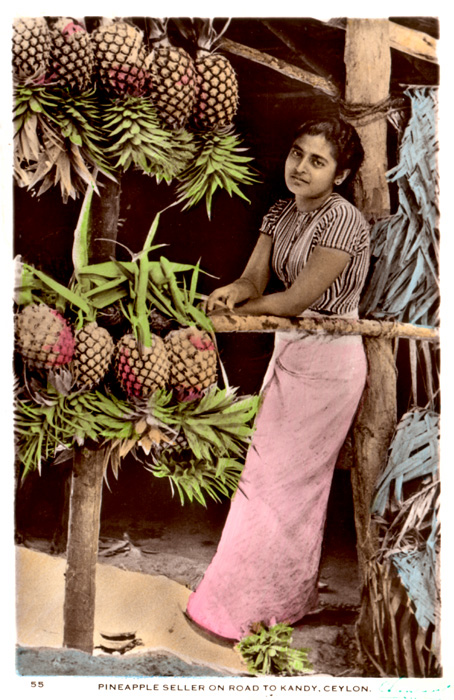
I love this postcard. Perhaps it’s the unusual presentation of the pineapples, or the hand-tinting, or the fact that the name of the city in Ceylon reminds me of a Martin Sexton song. Or perhaps I’m just a sucker for any postcard featuring a fabulous pineapple babe.
There’s actually a variety of pineapple called “Red Ceylon” (ananas comosus CV ‘Red Ceylon’), which is, quite appropriately, the most common pineapple grown in Sri Lanka (nee Ceylon) and India.
“The leaves are dark green with broad red central stripe and red spines on the margins. The fruit is small, 3 to 5 lbs (1.36-2.25 kg), yellow externally; has a thin core and very sweet flesh.”
Source: Purdue University’s
Center for New Crops & Plants Products
However, in 2000, Géo Coppens D’Eeckenbrugge and Freddy Leal had the audacity to suggest in The Application of the International Code of Nomenclature to Pineapple Cultivars that the “Red Ceylon” was the horticultural equivalent of an urban legend:
“Following the code, ‘Smooth Cayenne’ is clearly a cultivar….’Queen’ is also a cultivar. A detailed study might allow distinguishing clear differences between local populations or between clonal selections. However no sufficient data exist. Shoot and slip numbers are particularly variable traits. Some selections exhibit particular vigor, as ‘Mc Gregor’, but they cannot be distinguished from other similar selections. Thus, names as ‘Mauritius,’ ‘Malacca,’ ‘Red Ceylon,’ and ‘Buitenzorg.’ ‘Ripley Queen’, ‘Alexandra’ and ‘Mc Gregor’ must be considered synonyms to ‘Queen’. Only the tetraploid ‘Z’ or ‘James Queen’, found in South Africa (Nyenhuis, 1974), must be considered a distinct cultivar.”
Rubbish! And if you’re going to consolidate the naming conventions, surely an exotic name like “Red Ceylon” should win out over something as bland as “Queen.”
But they’re right about “Buitenzorg,” which should be taken out behind the nomenclature shed and put out of its misery.